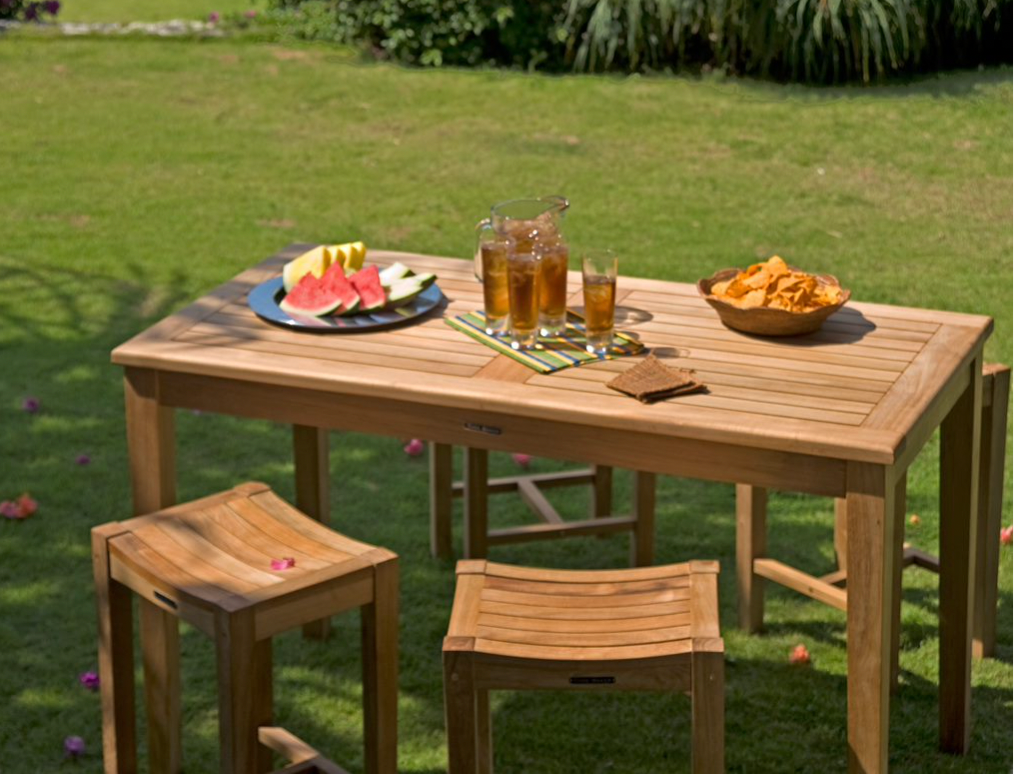There’s nothing quite like enjoying a summer afternoon in your backyard, whether it’s with a cold drink or simply basking in the sunshine. But before that, it’s time to get your outdoor furniture ready for the season.
Even if you already know how to weatherproof your outdoor furniture, it’s important to care for both wood and wicker throughout the season. Water and sunshine aren’t the only two things that can ruin your outdoor furniture: dirt, dust, and mildew can all be kept in check with some scheduled cleaning.
Not all outdoor furniture can be dealt with the same way, however. What might work on your teak table/barstool/etc might not work for that stunning new set of wicker chairs you just purchased.
In order to make sure you’re cleaning your furniture properly, and without lasting damage to the material, you should always start by considering the material used.
Summer is an ideal time to do some deep cleaning because the sunshine will help dry your furniture and avoid the potential mildew buildup from cushions and furniture damp.
Wipe it down
Whether you’re sprucing up your wood or wicker, always start off by grabbing a cloth (microfiber is ideal) and dusting the entire furniture off. After, dampen the cloth with either pure water or a mix of water and a mild soap (ideally a non-detergent liquid soap, such as Dawn) and use it to wipe all surfaces, including harder-to-get-to crannies.
Using warm water will be more effective in getting rid of tougher stains. Do NOT wash your outdoor furniture with a power washer. It can do irreparable damage to the material.
If you’ve wiped down your wooden furniture and you find there is still grime left, you can grab a soft bristle brush and more of the water-detergent mix to hand scrub the spots with significant stains.
For wood, there are several good options for soaps tailored specifically to wood furniture needs, such as the Daily Wood Cleaner and Cura Indoor White Soap.
We recommend you wipe your furniture down at least at the beginning and end of every season, but spot cleaning on a weekly basis is a good way to catch grime early on.
For wood furniture, make sure you have a soft-bristled brush and then scrub in the direction of the wood grain, especially when dealing with softwood. Sturdier wood, however, like teak, (an ideal type of wood for outdoor furniture) is less susceptible to scratches caused by hard bristles.
Regardless of if you’re doing a full wipe-down or doing a quick spot clean, make sure to never leave your wood furniture wet. Dry it off once you’ve cleaned it as best as you can, and ideally leave it to dry in the sun if the weather permits.
A good option for rainy days is to keep a furniture cover on.
Other options for wicker
For wicker, you can also use an oil-based soap; dilute it with water and use a cloth to wipe it down, paying extra attention to not miss any dirt that might be hidden in the crevices between the woven material.
If your wicker has been painted, you will need to be extra careful to avoid chipping the paint. Avoid excessive scrubbing and opt for a sponge for tough spots when possible, avoid steel wool and stiff paint brushes.
Resin (or synthetic) wicker is more durable, so if you’re worried about painted wicker holding up in the weather or want to avoid using painted outdoor furniture, consider purchasing resin wicker outdoor furniture rather than natural.
Getting tough spots out of wood
If you find that scrubbing the wood did not get rid of spots as well as you’d hoped, another option for wood is to use oxalic acid. The acid can remove stains without compromising the wood’s own color, making it a great option for when you need a bit of extra strength.
You need to remove varnishes and polishes before using oxalic acid so make sure to double-check instructions before proceeding. For stains left by iron frames and similar, check out the Oxalic Acid Wood Bleach.
You can also purchase Oxalic Acid through Amazon. Repeat if the stain is particularly stubborn.
Taking care of your cushions
Your furniture cushions should be as well taken care of as your furniture itself. Most of the time, your cushion tags will contain instructions.
However, if you don’t have the specific instructions at hand, most cushions can be cleaned with soap and lukewarm water. Before you wash the cushions, use a vacuum to get the dust off; dust and grime will always accumulate, so do this before soaking your cushions to avoid the dirt sticking to them.
If your cushions have removable covers you can toss those into the washing machine, otherwise, wipe your cushions with a mix of soap and water. You can also look for water-repellant cushions to help reduce the speed at which dirt accumulates.
Use a dry towel to soak up as much of the water as possible after (leaving your cushions wet can cause mildew) and leave them to air dry. If you took the cushion covers off, hang them up to dry. For additional protection, you can purchase a fabric protector.
Take advantage of the warmer months to keep your sets clean, because it’s taking care of your furniture is the first step to making sure they last many years to come.


